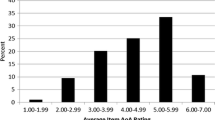Summary
The present research strategy utilizes factorial designs, functional measurement, testing of mathematical models and strong inference in the study of letter perception. To test the viability of this framework, subjects judged a number of ambiguous letters, varying between Q and G, in both a rating and discrete choice task. The letters were created by varying features of openness in the oval and the obliqueness of the straight line. Experimental and theoretical tests on the results indicate that multiple sources of featural information simultaneously contribute to the perception of letters. The features provide continuous rather than discrete information to an integration process and the evaluation of the information provided by one feature is independent of the nature of the other features. The integration process results in the least ambiguous letter feature contributing the most to the perceptual judgment. A fuzzy logical model developed in other domains, such as speech perception, provides a good description of exactly these phenomena.
Similar content being viewed by others
References
Anderson, N.H. (1981). Foundations of information integration theory. New York: Academic Press.
Anderson, N.H. (1982). Methods of information integration theory. New York: Academic Press.
Bouma, H. (1971). Visual recognition of isolated lower-case letters. Vision Research, 11, 459–474.
Carrithers, C., & Bever, T.G.R. (1984). Eye-fixation patterns during reading confirms theories of language comprehension. Cognitive Science, 8, 157–172.
Cattell, J. McK. (1886). The time it takes to see and name objects. Mind, 11, 63–65.
Chandler, J.P. (1969). Subroutine STEPIT — Finds local minima of a smooth function of several parameters. Behavioral Science, 14, 81–82.
Cheng, P.W., & Pachella, R.G. (1984). A psychophysical approach to dimensional separability. Cognitive Psychology, 16, 279–304.
Garner, W.R., Hake, H.W., & Eriksen, C.W. (1956). Operationism and the concept of perception. Psychological Review, 63, 149–159.
Gibson, E.J. (1963). Perceptual learning. Annual Review of Psychology, 14, 29–56.
Gielen, S.C., Schmidt, R.A., & Van Den Heuvel, P.J.M. (1983). On the nature of intersensory facilitation of reaction time. Perception & Psychophysics, 34, 161–168.
Gilmore, G.C., Hersh, H., Caramazza, A., & Griffin, J. (1979). Multidimensional letter similarity derived from recognition errors. Perception & Psychophysics, 25, 425–431.
Gough, P.B. (1984). Word recognition. In Pearson, P.D., Barr, R., Kamil, M.L., & Mosenthal, P. (Eds.), Handbook of Reading Research (pp. 225–253). New York: Longman.
Goguen, J.A. (1969). The logic of inexact concepts. Synthese, 19, 325–373.
Just, M.A., & Carpenter, P.A. (1980). A theory of reading: From eye fixations to comprehension. Psychological Review, 87, 329–354.
Loomis, J.M. (1982). Analysis of tactile and visual confusion matrices. Perception & Psychophysics, 31, 41–52.
Luce, R.D. (1959). Individual Choice Behavior. New York: Wiley.
Massaro, D.W. (1979). Letter information and orthographic context in word perception. Journal of Experimental Psychology: Human Perception and Performance, 5, 595–609.
Massaro, D.W. (1984). Building and testing models of reading processes. In P.D. Pearson, R. Barr, M.L. Kamil, & P. Mosenthal (Eds.), Handbook of Reading Research (pp. 225–253). New York: Longman.
Massaro, D.W. (1985). Attention and perception: An information-integration perspective. Acta Psychologica, 60, 211–243
Massaro, D.W., & Cohen, M.M. (1983a). Categorical or continuous speech perception: A new test. Speech Communication, 2, 15–35.
Massaro, D.W., & Cohen, M.M. (1983b). Evaluation and integration of visual and auditory information in speech perception. Journal of Experimental Psychology: Human Perception and Performance, 9, 753–771.
Massaro, D.W., & Oden, G.C. (1980). Speech perception: A framework for research and theory. In N.J. Lass (Ed.). Speech and Language: Vol. 3. Advances in Basic Research and Practice, New York: Academic Press.
Massaro, D.W., & Schmuller, J. (1975). Visual features, preperceptual storage, and processing time in reading. In D.W. Massaro (Ed.), Understanding Language (pp. 207–240) New York: Academic Press.
Naus, M.J., & Shillman, R.J. (1976). Why a Y is not a V: A new look at the distinctive features of letters. Journal of Experimental Psychology: Human Perception and Performance, 2, 394–400.
Neisser, U. (1967). Cognitive Psychology. New York: Appleton-Century-Crofts.
Oden, G.C. (1977). Integration of fuzzy logical information, Journal of Experimental Psychology: Human Perception and Performance, 3, 565–575.
Oden, G.C. (1979). A fuzzy logical model of letter identification. Journal of Experimental Psychology: Human Perception and Performance, 5, 336–352.
Oden, G.C. (1981). Fuzzy propositional approach to psycholinguistic problems: An application of fuzzy set theory in cognitive science. In M.M. Gupta, R.K. Ragade, & R.R. Yager (Eds.), Advances in Fuzzy Set Theory and Applications. Amsterdam: North-Holland.
Oden, G.C. (1984). Dependence, independence and emergence of word features. Journal of Experimental Psychology: Human Perception and Performance, 10, 394–405.
Oden, G.C., & Massaro, D.W. (1978). Integration of featural information in speech perception. Psychological Review, 85, 172–191.
Paap, K.L., Newsome, S.L., & Noel, R.W. (1984). Word shape's in poor shape for the race to the lexicon. Journal of Experimental Psychology: Human Perception and Performance, 10, 413–428.
Palmer, S.E. (1975). Visual perception and world knowledge. In D.A. Norman & D.E. Rumelhart (Eds.) Explorations in cognition. San Francisco: Freeman.
Palmer, S.E. (1978). Fundamental aspects of cognitive representation. In E. Rosch & B.B. Lloyd (Eds.), Cognition and Categorization, Hillsdale, New Jersey: Lawrence Erlbaum Associates, Inc.
Perfetti, C.A., Goldman, S.R., & Hogaboam, T.W. (1979). Reading skill and the identification of words in connected discourse. Memory & Cognition, 7, 273–282.
Platt, J.R. (1964). Strong inference. Science, 146, 347–353.
Pomerantz, J.R., & Garner, W.R. (1973). Stimulus configuration in selective attention tasks. Perception & Psychophysics, 14, 565–569.
Popper, K. (1959). The Logic of Scientific Discovery. New York: Basic Books.
Raab, D.H. (1962). Statistical facilitation of simple reaction times. Transactions of the New York Academy of Sciences, 24, 574–590.
Selfridge, O.G. (1959). Pandemonium: A paradigm for learning. In Symposium on the mechanisms of thought processes. London: HM Stationary Office.
Selfridge, O.G., & Neisser, U. (1960, August). Pattern recognition by machine. Scientific American, 203, 60–68.
Townsend, J.J. (1971). Theoretical analysis of an alphabetic confusion matrix. Perception & Psychophysics, 9, 40–50.
Zadeh, L.A. (1965). Fuzzy sets. Information and Control, 8, 338–353.
Author information
Authors and Affiliations
Rights and permissions
About this article
Cite this article
Massaro, D.W., Hary, J.M. Addressing issues in letter recognition. Psychol. Res 48, 123–132 (1986). https://doi.org/10.1007/BF00309160
Received:
Issue Date:
DOI: https://doi.org/10.1007/BF00309160




